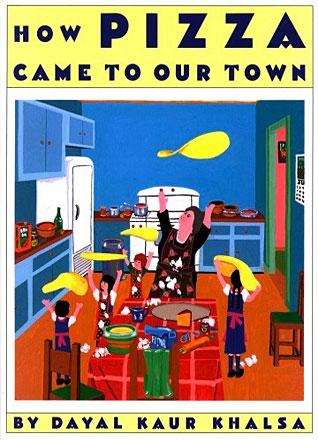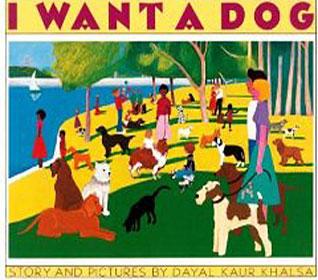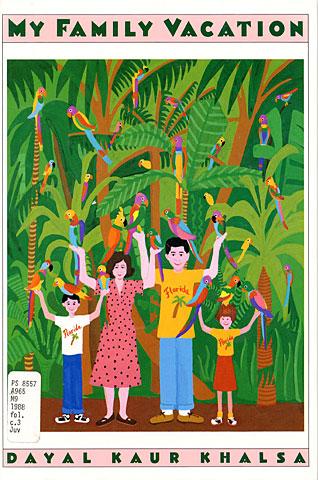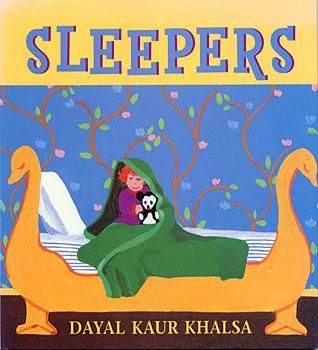Books
Dayal Kaur Khalsa:
Writer & Illustrator of Magical Children's Books
by MAY CUTLER
Dayal Kaur Khalsa
I have always thought I would like to die a quick, neat death without warning or pain. But the death of Dayal Kaur Khalsa changed my mind.
(1943-1989)
Suffering and awareness of the impending end can have positive values, if one can use them as Dayal Kaur Khalsa did. They can concentrate energy, release extraordinary creativity and, most surprising of all, bring more pleasure than all the preceding years of careless living.
Dayal - during the last four years of her life while she underwent operations, treatments and recurrent pain, battered by the alternate hope and despair that cancer inflicts - managed to write and illustrate seven books and write an eighth.
They shine with joy, humour, and the fun of life. The five published before she died moved her to the ranks of those rare and precious creators of children's books who can both tell a good story and illustrate it spectacularly. You can count on two hands their number throughout the world.
But it was not the success of her books that was so important to Dayal, although of course the accolades pleased. It was the actual work of making them; she admitted to laughing frequently as she put in the mischievous detail. I don't think she'd have traded any of it for a quick and easy death.
Her life had much loss and many disappointments.
The first occurred when she was five. She records it in Tales of Gambling Grandma: the death of the Jewish grandmother who gave her love and imaginative stories uninhibited by fact.
She grew up in Queens, New York, attended City College and then, in the way of so much youth in the sixties, wandered the United States and Mexico, living off little more than youth itself. She accompanied a lover to Canada in 1970, and stayed on after the relationship ended, supporting herself in desultory work that included cleaning other people's houses.
She lived mostly in Toronto, with an interlude on a farm near Millbrook, which is the setting for Julian, until 1980 when she moved to Montréal to live in a Sikh ashram. She would remain there until the beginning of 1989 when she moved to Vancouver to be closer to old friends during her last months.
Becoming a Sikh and being in the community helped her get her life together and provided the ordered stability and comradeship missing since childhood. She was married briefly during this period; the disappointment was particularly poignant because her last chance to have a child ended in a miscarriage.
I met her in 1982 when she brought illustrations to show us. They did not impress for idea, content, or technical proficiency, but they had one quality that is less common than you would think: strong colour sense. She could mix garish colours together-rather like the Berber women of Morocco - and come up with a vibrant and united whole.
The discovery was just being made at that time that babies don't like pastel colors; they can't even see the pale pinks and blues that parents have long adored. Dayal's colours led me to suggest a series of object recognition pictures and the twelve Baabee board books resulted.
Babies loved them but adults didn't like their crude simplicity, the big-eared baby who came in skin shades of pink, yellow, brown, and blue. Dayal developed the images and colours, testing them on babies at a Sikh camp in New Mexico where she summered. They were indeed an experiment and an exercise, and they gave no hint of what was to come.
Dayal talked about the Grandma book long before she showed it to us. I remember staring, incredulous, at the first illustrations, at Grandma taking an orange-juice bath on a train, at the fridge filled with borscht (beet soup) in case the Cossacks came back.
Here was a unique talent.
Because Grandma was set in New York, I knew that if I published it in both Canada and the U.S as other Tundra books, it would fall between two nationalisms. Canadians would be lukewarm to it as an American book and leading American publications such as The New York Times would not review it because it didn't come from an American publisher.
I arranged for her to show it to a New York agent. It sold first time out, first day out. But it was a bittersweet moment. She told me of leaving her agent's office with the cheque - the largest she'd ever held in her hand - and entering a nearby church to sit and think.
Only a few days earlier, a tumour had been found on her breast.
All of us at Tundra loved her and felt very close to her and her work. She had stipulated in all contracts the agent made that Tundra would have exclusive Canadian rights to whatever she did and she brought in her books at their various stages to show us. Each visit became an office party. We all gathered to look at the illustrations, listen to her tell the story and laugh with her.
She completed the illustrations before she wrote the story. As she phrased it, she "composed" the text while she painted.
Her illustrations are full of in-jokes, many of them take-offs or take-outs from some of the most famous art in the world. We recognize easily the cover of I Want a Dog as a fun variation of Seurat's Sunday Afternoon on the Island of La Grande Jatte: his park becomes a paradise for dogwalkers while dogless little May sits with her substitute roller skates.
Do we also recognize the girl's bedroom in Grandma is designed after Van Gogh's? Art detectives can search out other fun borrowings.
She was a self-taught artist. She started art lessons once in New York, but gave up after seeing an Edward Hopper exhibition because "I could never paint that well." Yet, she was in the mainstream of several modern art movements.
Her illustrations are pop art without the sterility, and magic realism without the sentimentality.
She was extremely generous with her art. Her books have as many as twenty-five paintings - in contrast to half that in many children's books - plus endleaves that are as caringly crafted as the interiors.
I asked her once where she got the energy and time to develop the stories and do fifty or sixty illustrations a year. (This was between operations, hospital visits, chemotherapy, and all the accompanying discomfort.) She grinned: "It's easy, May, I've got a deadline."
Several art galleries approached her to exhibit and sell the art in her books but she refused. I was puzzled by this because, in spite of advances from her U.S. publisher, she was scarcely well-off. Then one evening as we sat talking she explained why she wanted all her illustrations kept together.
Did I think the National Library in Ottawa might like to own them? She wanted to make a gift to Canada, she said, because the country had been so good to her. She made her will accordingly.
It's hard still to think that there will be no more laughing visits. There will, however, be another book, in addition to Cowboy Dreams. She wrote The Snow Cat but could not illustrate it.
Shortly before her death, she phoned from Vancouver. "I want to say goodbye, and thank you." As if it wasn't us who should be doing the thanking.
I have had a few honours in my life, but I think the one I shall always be proudest of is that she named the spunky, irrepressible heroine of so many of her books "May," after me.
Books & Films by DAYAL KAUR KHALSA
The Baabee Books Series. Tundra Books, 1983.
Series 11.Tundra Books, 1983.
Series 111: Ham Birthday, Baabee Merry Christmas, Baabee Bon Voyage, Baabee Welcome, Twins. Tundra Books, 1984.
How Pizza Came to Our Town. Tundra Books, 1989.
I Want a Dog. Tundra Books, 1987.
My Family Vacation. Tundra Books, 1988.
Sleepers. Tundra Books, 1988.
Tales of a Gambling Grandma. Tundra Books, 1986.
Snow Cat, the Film. Story and Illustrations by Dayal Kaur Khalsa. Maureen Stapleton (Narrator). Sheldon Cohen (Director). Sheldon Cohen, Kenneth Hirsch & Marcy Page (Producers). Montreal, PQ: The National Film Board of Canada, 1998. 23 min., 2 sec., VHS, $39.95, Order Number: C9198 081. Preschool-grade 2 / Ages 3-7.
May Cutler is Publisher of Tundra Books.
March 20, 2009






